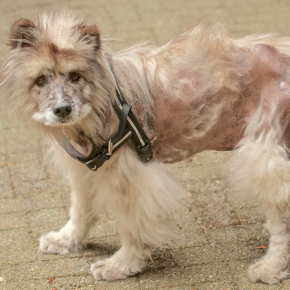
Common causes of alopecia in dogs
May 21, 2023
Alopecia is the partial or complete lack of hairs in areas where they are normally present. It can be worrying to see your dog losing hair, but the underlying cause can be successfully treated most of the time. Here is our list from Vet Albert Moussafir displaying common causes of alopecia in dogs.
- Ectoparasites – most commonly mange mites, fleas, lice, mosquitos, flies and spider bites
- Hair follicle inflammation
- Allergic reactions to bites, food or contact with a foreign body
- Bacterial or viral skin infections
- Anxiety related to self-trauma
- Endocrine diseases such as hypothyroidism, hyperadrenocorticism and flank alopecia
- Vitamin deficiencies due to an unbalanced diet
- Genetic and autoimmune disorders
- Environmental (dirty, hot, humid conditions)
- Vaccines, chemical exposure or burns
If you are unsure about what could be causing alopecia in your dog, do contact our Oakleigh Road North practice on 020 8368 9798.
Get your dog diagnosed – book now
Diagnosis and treatment of alopecia in dogs
To diagnose alopecia in dogs, our vets will try to identify the root of the problem. They do this by gathering a history, observing the site of hair loss, and looking out for a waxy/greasy feel to the skin as well as a yeasty smell. They will then perform one or more diagnostic tests such as a skin scrape, bacterial culture, or blood test to confirm the underlying cause of the alopecia.
Albert advises that due to the plethora of causes of alopecia, there is a wide variety of treatments. Some treatments include antifungals, antibiotics, medicated shampoos, sprays or ointments, anti-parasiticides, anti-histamines, diet or environment changes and surgical removal.
It’s important that you get a veterinary diagnosis for your dog’s hair loss and follow their treatment advice as not applying the correct products for the cause may not help or could make the condition worse. Get in touch to book an appointment with Albert or any the vets at Whetstone.
Recovery and management
Once the cause of the alopecia has been identified and the treatment has been administered, your dog will most likely recover successfully. To help maintain your dog’s health, avoid known allergens in the environment if this is the cause and keep them up to date with parasite control and grooming.
If your dog begins to develop alopecia again, do contact our veterinary team to prevent painful development of the symptoms.